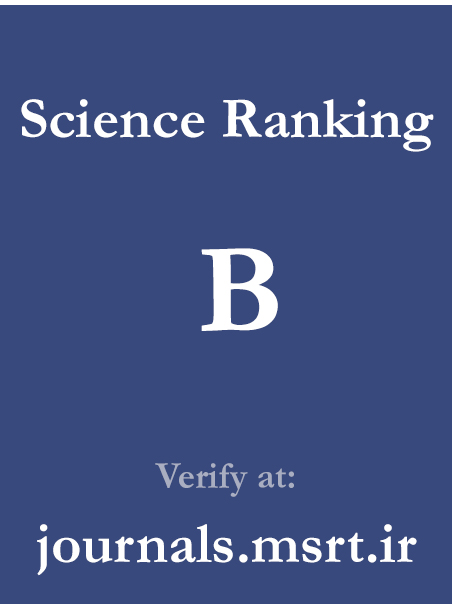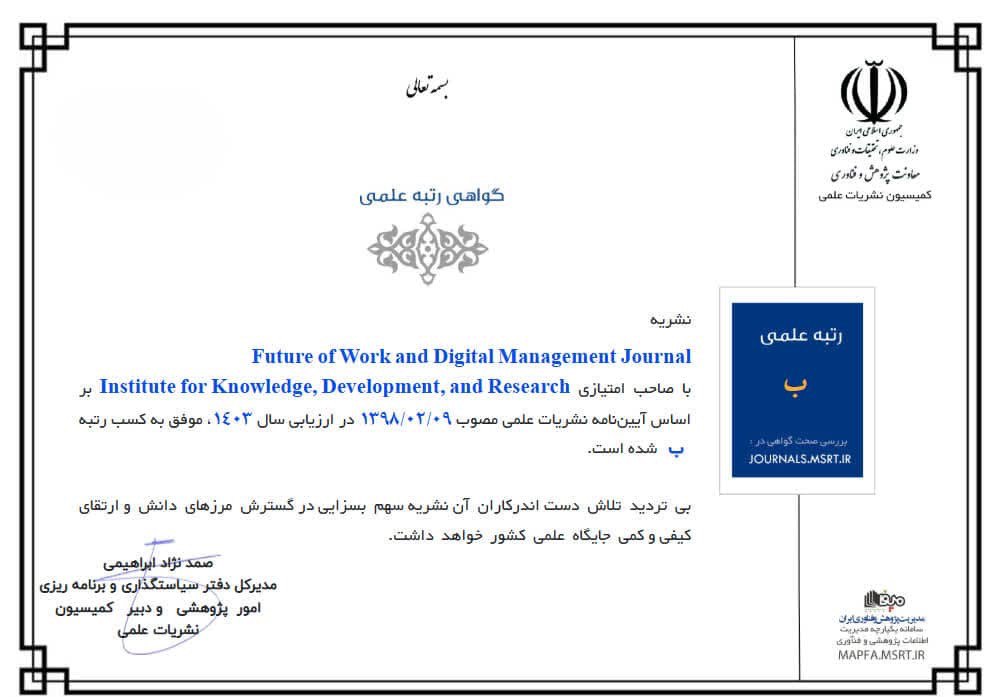Identifying Key Metrics of Digital Transformation Readiness
Keywords:
Digital transformation readiness, Organizational infrastructure, Leadership commitment, Cultural change, Strategic alignmentAbstract
This study aimed to identify and conceptualize key organizational metrics that define digital transformation readiness across infrastructural, cultural, and strategic domains. This qualitative research employed a constructivist approach using semi-structured interviews with 26 participants from various organizations based in Tehran, including IT professionals, innovation managers, and strategic decision-makers. Participants were selected via purposive sampling, and data collection continued until theoretical saturation was reached. Interviews were transcribed verbatim and analyzed using thematic analysis, facilitated by NVivo software. The analysis process included open, axial, and selective coding to extract and refine categories and subcategories related to digital transformation readiness. Thematic analysis revealed three overarching categories of digital transformation readiness: organizational capability and infrastructure, human capital and culture, and strategic alignment and governance. Within these categories, key subthemes included IT infrastructure preparedness, cybersecurity infrastructure, data governance, employee digital competency, leadership commitment, learning culture, strategy integration, KPI systems, and policy adaptability. Participants highlighted the interplay between technical systems and human readiness factors, underscoring the importance of alignment between strategic intent and operational capacity. The findings support the notion that readiness is a dynamic, multi-layered construct involving both internal and external organizational dimensions. Comparisons with existing literature further validated these metrics as practical indicators of readiness across sectors. This study provides a comprehensive, empirically grounded framework for assessing digital transformation readiness by integrating infrastructural, human, and strategic components. The findings offer actionable insights for organizations seeking to benchmark their preparedness and design interventions that foster successful digital transitions. Readiness should be treated as an evolving organizational capability that requires continuous evaluation and adaptation in response to technological and environmental change.
Downloads
References
[1] J. Chen, Y. Tian, and Z. Shen, "Research on the Impact of Digital Transformation on Commercial Bank Performance," Frontiers in Management Science, vol. 3, no. 3, pp. 31-34, 2024, doi: 10.56397/fms.2024.06.04.
[2] D. Petrović, Z. Mitrović, and P. Stanimirović, "Conceptual Framework for Measuring the Success of Digital Transformation Projects," pp. 316-326, 2022, doi: 10.1007/978-3-031-18645-5_19.
[3] K. Oh, H.-S. Kho, Y.-J. Choi, and L. Seogjun, "Determinants for Successful Digital Transformation," Sustainability, vol. 14, no. 3, p. 1215, 2022, doi: 10.3390/su14031215.
[4] P. Pfister and C. Lehmann, "Measuring the Success of Digital Transformation in German SMEs," Journal of Small Business Strategy, vol. 33, no. 1, 2023, doi: 10.53703/001c.39679.
[5] M. Nasiri, M. Saunila, and J. Ukko, "Digital Orientation, Digital Maturity, and Digital Intensity: Determinants of Financial Success in Digital Transformation Settings," International Journal of Operations & Production Management, vol. 42, no. 13, pp. 274-298, 2022, doi: 10.1108/ijopm-09-2021-0616.
[6] B. Kelley, "Successful Digital and Business Transformations," pp. 243-251, 2023, doi: 10.1007/978-3-031-36193-7_21.
[7] M. Schank, "The Key to Digital Transformation Success," pp. 3-13, 2023, doi: 10.1007/978-1-4842-9816-9_1.
[8] A. A. Maazmi, S. Piya, and Z. C. Araci, "Exploring the Critical Success Factors Influencing the Outcome of Digital Transformation Initiatives in Government Organizations," Systems, vol. 12, no. 12, p. 524, 2024, doi: 10.3390/systems12120524.
[9] E. Bahiroh and A. Imron, "Innovative Human Resource Management Strategies in the Era of Digital Transformation," Productivity, vol. 1, no. 2, pp. 154-162, 2024, doi: 10.62207/6wnrgj39.
[10] M. Triani, D. G. Hasan, and Y. B. Susanto, "Analyzing Organization Culture’s Role on Digital Transformation During Pandemic Era: An Ethnographic Study," Indonesian Journal of Multidisciplinary Science, vol. 2, no. 11, pp. 4023-4031, 2023, doi: 10.55324/ijoms.v2i11.625.
[11] V. Y. Zakharov, E. N. Ludushkina, M. V. Kislinskaya, E. V. Kornilova, and A. Novikov, "Digital Transformation of Enterprises: Trends, Factors, Results," Nexo Revista Científica, vol. 35, no. 01, pp. 133-145, 2022, doi: 10.5377/nexo.v35i01.13924.
[12] M. E. Adib and M. A. Nafzaoui, "The Conditions for a Successful Digital Transformation for a Successful Audit Firm," 2022, doi: 10.5281/zenodo.6395367.
[13] K. H. Alshammari, M. Alshallaqi, and Y. H. Al‐Mamary, "Digital Transformation Dilemma in the Era of Changing Dynamics: How Organizational Culture Influence the Success of Digital Transformation," Human Systems Management, vol. 43, no. 4, pp. 455-472, 2023, doi: 10.3233/hsm-230163.
[14] H. Zhu et al., "Building a Digital Transformation Maturity Evaluation Model for Construction Enterprises Based on the Analytic Hierarchy Process and Decision-Making Trial and Evaluation Laboratory Method," Buildings, vol. 14, no. 1, p. 91, 2023, doi: 10.3390/buildings14010091.
[15] T. Wahyuni and A. Tjala, "MEASUREMENT INSTRUMENTS FOR THE DIGITAL TRANSFORMATION in SCHOOLS," International Journal of Business Law and Education, vol. 4, no. 1, pp. 41-46, 2023, doi: 10.56442/ijble.v4i1.109.
[16] E. M. Pacyna and G. O. Langford, "Successful Digital Transformations Demand Process and Measurable Functions," pp. 1-9, 2022, doi: 10.23919/picmet53225.2022.9882690.
[17] M. Schank, "Digital Transformation Success," 2023, doi: 10.1007/978-1-4842-9816-9.
[18] A. Babenkova, "DIGITAL TRANSFORMATION Ingredients for Success," 2022, doi: 10.13140/rg.2.2.30332.62089.
[19] Z. Cai, "Digital Transformation and Business Model Innovation: Navigating Opportunities and Challenges," Highlights in Business Economics and Management, vol. 43, pp. 44-51, 2024, doi: 10.54097/qvp4my26.
[20] M. S. Ledovskoy, "Topical Issues in the Formation of State Policy in the Field of Digital Transformation," Ekonomika I Upravlenie Problemy Resheniya, vol. 2/3, no. 134, pp. 1112-216, 2023, doi: 10.36871/ek.up.p.r.2023.02.03.016.
[21] S. A. Wright, "Organizational Readiness/Maturity Considerations for Blockchain Adoption," pp. 344-365, 2022, doi: 10.4018/978-1-7998-9764-4.ch016.
[22] D. V. Shvechihin and M. A. Sheikina, "Improving the Efficiency, Safety and Manageability of Oil Transportation Processes," Vestnik Universiteta, no. 3, pp. 84-89, 2022, doi: 10.26425/1816-4277-2022-3-84-89.
[23] N. M. Sikki and J. R. Batmetan, "Analysis of Digital Transformation Strategy Opportunities and Threats of Food Stalls Small Medium Enterprises in the Industry 4.0," Ijite, vol. 1, no. 3, pp. 98-102, 2022, doi: 10.62711/ijite.v1i3.63.
[24] A. Saifunnasrullah and K. Budiman, "Digital Transformation Analysis in the Manufacturing Module in Aluminium Companies Using the TAM Method," Journal of Advances in Information Systems and Technology, vol. 5, no. 1, pp. 49-63, 2023, doi: 10.15294/jaist.v5i1.66567.
Downloads
Published
Submitted
Revised
Accepted
Issue
Section
License

This work is licensed under a Creative Commons Attribution-NonCommercial 4.0 International License.








